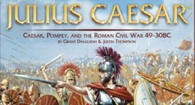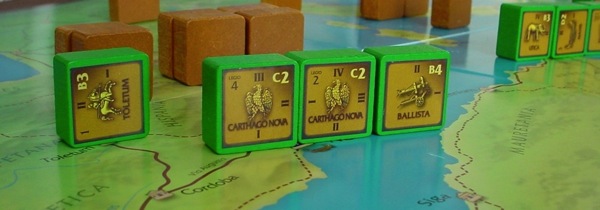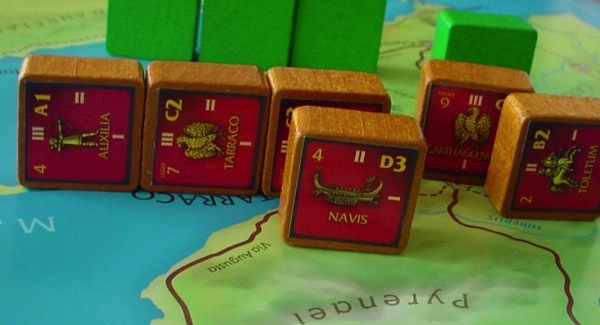Julius Caesar – Boardgame Review
 Julius Caesar: Caesar, Pompey, and the Roman Civil War, 49–30 BC. Boardgame. Publisher: Columbia Games. Designers Justin Thompson and Grant Dalgliesh. Developed by Tom Dalgliesh. $64.99
Julius Caesar: Caesar, Pompey, and the Roman Civil War, 49–30 BC. Boardgame. Publisher: Columbia Games. Designers Justin Thompson and Grant Dalgliesh. Developed by Tom Dalgliesh. $64.99
Passed Inspection: Easy to learn with great replay potential
Failed Basic: High price for the goods received
Pompey’s forces had fallen back from Neapolis after losing to Caesar; Pompey was lucky to have ships available to assist his escape to Sicilia. But the gods were not pleased, and Vulcan showed his displeasure by having Mt. Etna erupt, sending smoke, ash and gases to descend upon Pompey’s men as they marched to Syracuse from Messana. When messengers arrived to relay the news to Caesar, who had joined with Antonius to plan future campaigns, he immediately had auguries done to see if a swift attack would be favorable. Antonius was dispatched to Rhegium to cross the Straits to Messana, and Caesar got ships from Massilia to move his troops across the Mare Tyrrhenum and land at Lilybaeum. Pompey in the meantime looked for escape from Syracuse to either Utica or east towards Egypt where he had other forces to rebuild his Army. He sent offerings to Mercury to assist his cause. Would the god answer?
{default}Julius Caesar is a great game that is really simple to learn and will be a challenge to master. It is the second block game I have in my collection, the other being the Avalon Hill version of Napoleon, which Columbia Games acquired and sells. I enjoy them both, but I enjoy Julius Caesar much more. It covers the Roman Civil War; each player is trying to control a majority of the Roman Empire and/or vanquish the other thru maneuver and battle.
I’ll address the price first, $64.99, as it is my only complaint. This is one of the more expensive titles produced by Columbia Games. It comes with 63 blocks for the playing pieces and two spares for each side, for a total of 67. You get 27 playing cards that are just as well made as those found in any GMT game that uses cards. There is a 17” x 33” map made of a lighter cardstock than the cards but it is heavier than a map sheet from a GMT game. The map has a glossy surface and the place names are easy to read, but it will not lay flat without counter-bending the folds (or laying an acrylic sheet over it). The rule book is 8 pages. One page is devoted to the start forces and their deployment on the map, and one page consist of a historical timeline, game credits and an index. There are a few examples of game actions. Oh, you also get 4 six-sided dice. A similar-sized product from Worthington Games, Blood of Noble Men, (about the Alamo) has a price of $39.95. The GMT game, Command and Colors: Ancients is a larger work with 345 wooden blocks, 7 dice, 60 cards, and a large map and is priced at $65.00. I expected a little more in the box for the price that Columbia charges.

However, the game is truly simple in its mechanics and a snap to learn and play. It lists its age range as 12 and up, but, I have found comments from people that claim children as young as 10 have learned to play the game. The Caesar player has his work cut out for him, as he must go on the attack to seize VP locations, while the Pompey player is better positioned to take some VP locations and begins the game controlling more than Caesar. The total number of forces is equal but the quality and type are a little varied. Generally, Caesar’s troops are better than Pompey’s but Pompey begins the game with more troops. Learning the names and locations of the ancient cities can be a small bother, but I took it as a learning experience. Tarraco? Where’s that? Play time is listed as being 1 to 3 hours, which is very realistic and I have found can include set-up time.
The game is 5 years (turns) long; each year consists of playing through a hand of five cards. Each player gets six cards dealt and discards one, leaving five rounds of play to a year. The first card played by each player in a year is played simultaneously, to determine initiative for the remainder of the year. The cards are shuffled at the beginning of a new year.
Gods and Legions
The cards are used to conduct the movement of groups of blocks and to levy troops. Twenty of the cards have a standard with a Roman numeral of I thru IV; the number represents how many groups the player can move. Silver discs on the standard show how many strength points the player gets to create a unit(s) or reinforce an existing one. Seven of the cards represent the influence of the Gods and can really pack a nasty punch if played at the right time. Often, you just never seem to have the right Gods card when you could really use them. Some of the locations on the map are a little close for large groups to gather in, so players might have to use some careful handling of the blocks to keep things from getting jumbled.

When all else fails, make an offering to the gods.
The blocks create a fog of war for the players. Some things can be figured out about the creation of new units, however, such as: Legions can only be raised in their home city, so if you don’t control Rome you cannot build the Rome Legion from your force pool. Navis (Navy) can only occupy port cities or sea zones. Playing the game is a mental exercise of trying to remember where your opponent’s previously exposed units have been and where are they going, while watching where your opponent builds things. I once went on the attack thinking I’d hit some Auxillia and maybe a cavalry unit. Instead, I found two Legions, one of which was very formidable. Ouch.
Movement consists of selecting a group and moving it along roads or by sea. Movement is between cities; you can move two cities in a turn, or move one city and make an attack. The network of major and minor roads limits movement because roads can only handle a limited number of troops per round. Groups can move together, split up, or drop off units along the way
Combat—Roman against Roman
Combat is done in four rounds, and the defender usually gets to fight first. All hits are immediately applied. And, if that isn’t tough enough on the attacker, he must withdraw from combat on the fourth round if the defender hasn’t been destroyed— which means the defenders get a free parting shot at him. Units are rated A thru D, with A units fighting before Bs and so on. The units have a number next to the letter that represents the number that needs to be rolled (or lower) on a d6 to get a hit on your opponent. So an Auxillia unit rated as an A2 will fight first and needs a 2 or less to get a hit. A unit gets one die for every strength point. In a battle, the defenders A-class units fight before the attacker’s As, then the same happens for the B’s and so on. Casualties are first applied to your opponent’s strongest unit. If there is a tie, then the owning player is allowed to determine which unit takes a hit.
Just so you don’t pile all your units in one large blob, the Winter phase ends each year with nasty effects for overstacking cities and for ships at sea without a friendly port. If you control her, Cleopatra goes home to Alexander from wherever she is located. A player wins if at the end of any turn he has 10 VPs; otherwise, at the end of the game the player with the most VPs wins. If a draw occurs, Caesar wins.

There is ample opportunity for replay, as there are many different strategies and the cards offer enough random chance to waylay the best-laid plans in the short term. Of course, it doesn’t hurt if you have an opponent that rolls poor dice.
I found that playing solitaire is possible, but you lose a little of the sequencing of your actions if you desire to keep an element of fog of war by not looking at the cards in each side’s hand. I play with both hands being blind, so I never know which card I am going to play or what I have in the hand. It’s rather difficult to execute an attack that must come from two different cities if you keep pulling cards that allow only one group to move and you don’t know if you have a two or better in hand.
Solitaire rating: Average; 3 out of 5
Michael Peccolo is a retired Armor Major from the US Army with overseas duties, Company commands and additional assignments in recruiting and ROTC. He lives in Tennessee where he raises horses with his wife. He volunteers at Ft. Knox to be a Civilian on the Battlefield.


Thanks for the great review.
Grant
http://www.columbiagames.com
I did my review here + historical background:
http://meshtime.com/2011/08/29/julius-caesar-critical-review-the-64-question/
My challenge with the game or perhaps specifically with block games is the abstraction of theme. The flavor of the era does not come thru in block games for me. Am I fighting with an Elephant, a Scorpion or a Tiger Tank…?
Video Play thru here: http://www.youtube.com/watch?v=AJVuUAJhKgg
One of the greatest game ever designed. Truly chesslike in that simple elegance masks levels of complexity and contingencies. You will play this one over and over and over.
Really..best ever?
While it is a fine example of a block game, it lacks historical feel.
the cards are somewhat too powerful
the board is cheap
the game play predictable after a few plays
It feels like any other block game to me. Compared to other titles from Columbia I dont think this is their best.
It certainly is not chess like to me.
Historical feel is in the nervous system of the beholder.
I find that the cards and full naval strategies remove predictability pretty well.
Which block games do you prefer ?I